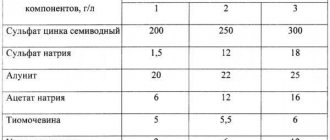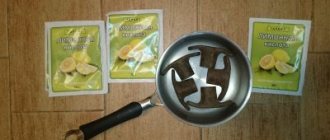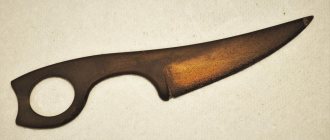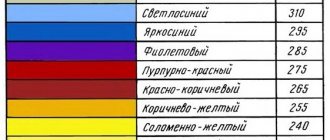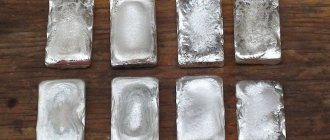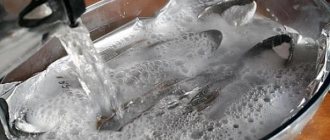Metal oxidation occurs when exposed to moisture and oxygen. As a result, a reddish-brown coating forms, which over time destroys the material.
To eliminate corrosion, not only purchased products can be used, but also simple home recipes.
Read the article about how to remove rust from metal at home using folk remedies.
Causes of rust
The formation and spread of rust throughout a metal structure occurs due to an oxidative reaction. The main unfavorable factor is severe dampness or high humidity of the environment. Oxidation entails formation deformation and destruction of the crystal lattice. The main causes of rust and destruction of iron:
- poor quality protection. The metal must be covered with a layer of paint. This allows you to minimize the contact of “bare” iron with water. The problem is that over time the paint begins to crumble, moisture gets into the places where the coating is damaged and starts corrosion;
- no processing. It is recommended to coat the metal with special anti-corrosion substances before painting. This will provide additional protection and, in the event of spot rust formation, will not allow it to spread further;
- scratches and chips. Such deformations must be immediately cleaned and processed, otherwise the destruction will affect all layers of the material, and it will not be possible to restore its appearance.
For reference! Corrosion is the process of destruction of a metal or alloy, which is triggered as a result of chemical, electrochemical or physicochemical contact with the environment. This process is not harmful to gold, palladium, rhodium and pure silver.
A little chemistry to understand the process of rust formation on metal
Rust is a product of iron oxidation. Most often it is a chemical compound Fe₂O₃. This oxide gives a reddish tint. However, dark inclusions can often be observed.
They indicate that the metal has not only trivalent properties, but also divalent properties. Therefore, the oxide will be written with the chemical formula FeO.
Based on numerous studies, it has been established that Fe₂O₃ predominates. It occurs in 85...88% of cases.
Information for the curious. Iron is smelted from ore. It is usually denoted as a Fe₃O₄ compound, but this formula does not give the real picture. In nature, the compound occurs in blast furnaces at temperatures above 850 ⁰C.
In the open air, iron actively interacts with oxygen in the air. Therefore, an oxide film forms quite quickly. In practice, to prevent oxidative processes, the metal surface is protected.
The density of the oxide film can be different. If a steel object has been exposed to the open air for a long time, the metal may be riddled with holes consisting of oxide (rust). In fact, it completely loses its properties.
Items that have recently been left without additional protection are covered with only a thin coating. The thickness of the oxide film is measured in microns. In such a case, the strength of its adhesion is insignificant. It can be easily removed from the surface.
Attention! Iron oxide FeO is considered protective. If this particular compound is present on the surface, then it does not allow red rust (Fe₂O₃) to spread. Bivalent oxidation occurs when the metal is heated above 250…270 ⁰С.
When smelting iron from ore under the influence of high temperature, processes of metal reduction with carbon and hydrogen occur:
- 3Fe₂O₃ + CO = 2Fe₃O₄ + CO₂;
- Fe₃O₄ + CO = 3FeO + CO₂;
- FeO + CO = Fe + CO₂;
- 3Fe₂O₃+ H₂ = 2Fe₃O₄ + H₂O;
- Fe₃O₄ + H₂ = 3FeO + H₂O;
- FeO + H₂ = FeO + H₂O
In addition to the formation of pure iron Fe, iron carbide Fe₃C is formed in the blast furnace process. The reaction of its formation occurs at a temperature of 950...1000 ⁰С.
3Fe + 2СО = Fe₃C + CO₂.
The flue gas contains carbon monoxide CO₂ and water vapor H₂O. At a temperature of 1536 ⁰C, iron Fe melts.
In nature, the opposite process occurs. At the same time, cast iron, due to its high iron carbide content, oxidizes several times slower than steel.
Important! Steel is considered a mechanical combination of iron and carbon, provided the content does not exceed 2.14%. As the carbon content increases, the alloy becomes cast iron.
Mechanical methods
Such methods allow you to remove rust from metal using mechanical action. In terms of effectiveness, they are inferior to chemicals, but people are still in no hurry to use the latter. This is due to the fact that metal damaged by corrosion is fragile, and aggressive action is undesirable for it. Before carrying out any treatment, it is necessary to assess the affected area and the depth of oxidation.
Metal brushes
If the surface affected by rust is small, you can clean it with a brush with metal bristles. The devices are presented in an assortment and may differ in the stiffness of the wire and the method of attaching the handle. The best option is brass bristles, suitable for quickly cleaning plaque.
Cleaning process:
- Securely fix the element in a vice so that it does not move.
- Rub the rusty surface with a brush, making movements in a circle.
- Remove excess chips to identify the problem area.
- Repeat until the desired effect is achieved.
The result depends on the initial state of the metal and the hardness of the pile. There is no point in using a hand brush to remove rust from large areas because the process will be long.
Special attachments
Special mechanical brush attachments will help quickly remove rust from metal surfaces. They are end and radial. They are installed in modern electric drills and screwdrivers. The device works effectively and allows you to clean a large area at a time, but you need to learn how to hold it correctly. It is difficult to process with circular movements because the tool “tears out” from your hands. Additionally, it is worth using a special retainer.
Foil
Regular aluminum foil, which housewives use in the kitchen, helps to remove rust from small areas of metal. This method will help if the rust layer is insignificant, otherwise it will be ineffective. To clean the metal, the foil must be treated with 3% warm vinegar, and then rub the rusty layer of metal in a circular motion.
Sandblasting
To carry out the treatment you will need a special sandblasting machine. They are used in the production of metal structures. The principle of cleansing is the action of sand and its contact with metal at high speed. When they hit the surface, the grains of sand break off the rust and the affected particles fly off. The advantage of this method is its high efficiency, but the disadvantage is the cost; buying a device for use at home is unreasonably expensive.
Preventive actions
To protect metal from corrosion, you can perform a number of preventive procedures:
- After moisture gets on a metal surface, wipe it dry with a cloth.
- Store metal products in areas with low humidity.
- If you need to paint a surface, first of all, it needs to be cleaned of the old decorative layer. Then remove dirt, degrease and apply primer. Only after the primer can a coat of paint be applied.
When removing rust, you can combine several methods.
This will increase the cleaning efficiency. People who do metalworking, repair cars, or work with metal tools need to know how to clean the material from corrosion. It is not necessary to use special equipment for this. It is enough to use available means.
Chemical methods
Chemical solvents help quickly remove rust from metal. You need to choose a suitable substance in accordance with the volume of the lesion. In advanced cases, for complete cleaning, it is recommended to combine several methods simultaneously.
Attention! Before carrying out work, hands should be protected with rubber gloves to prevent chemical burns or skin irritation.
Acids
Acid compounds help remove traces of rust on any metal. You can use acids such as:
- vinegar To remove rust from metal, you need to use concentrated acid, it is better to take 70% essence. Small elements are immersed in the solution and soaked in it for 15-40 minutes (depending on the degree of damage). If a large layer of metal is damaged, vinegar is sprayed onto it from a sprayer or wiped with a moistened cloth;
- dairy. To obtain a cleaning composition, mix 50 ml of lactic acid and 100 g of liquid paraffin. Apply the resulting mixture to the surface and leave to act for 10-20 minutes. After the specified time, the rust crystallizes and moves away from the metal itself. At the end, the iron structure is treated with Vaseline oil;
- lemon To clean surfaces from rust, use a solution with a mass fraction of the active substance of at least 5%. The rusty iron product is left in the liquid for several hours and then treated with a brush. The combination of chemical and mechanical methods has maximum efficiency;
- ketchup and tomatoes. This method of removing rusty deposits is unusual. Spoiled ketchup or tomatoes can be used as the active substance. Tomato puree or sauce is applied to the coating with a synthetic brush and lightly rubbed, left to react for 20 minutes, and then washed off;
- sorrel Dissolve 4 tbsp in 200 ml of water. l. substances and immerse the rusty element in the resulting solution for 30 minutes. If corrosion has severely damaged the metal, it is necessary to remove the bulk of it with a brush. After soaking, the part must be carefully removed from the water and then cleaned with a brush;
- orthophosphoric. 150 g of acid is dissolved in 1 liter of clean water and the part is immersed in the container for 1 hour. During this time, the composition must be stirred periodically;
- sulfuric To remove rust, use 5% acid, which is carefully spread over the coating with a sponge and left for 1-2 hours. After processing, the element is dried;
- salt. 5 ml of the active substance is dissolved in 100 ml of water and 1 g of hexamine is added. Place the object in the liquid for 1 hour, large elements are smeared with a brush. After completion of the interaction, the part is washed, additionally cleaned and anti-corrosion treatment is carried out.
Advice! If the item is small in size, it is convenient to choose the immersion method. When corrosion affects large layers of iron, it is better to carry out spot treatment followed by mechanical cleaning.
Baking soda
Ordinary baking soda helps restore the original appearance of the metal. It must be diluted with water to make a paste. Next, apply the resulting mass with a brush, try to rub in and leave to react for 20-30 minutes. After this, remove the composition and clean the part with aluminum foil. Before anti-corrosion treatment, rinse with water.
Hydrogen peroxide
Hydrogen peroxide helps to revive metal instruments and restore their appearance. To prepare it you need to mix:
- water – 100 ml;
- citric acid – 10 g;
- peroxide 3% - 50 ml.
Place metal products in the resulting liquid and leave in it overnight to react. In the morning you can evaluate the result - surface rust should come off in one use; finally, just rinse the tool with water. If the corrosion is old, it will be easier to remove it mechanically after soaking.
Formalin
A formalin-based solution prepared in the following proportions will help clean a rusty surface:
- formalin – 250 g;
- clean water – 250 g;
- caustic soda – 50 g;
- ammonia 1% - 70 ml.
The resulting concentrated solution is poured into a deep container and 1 liter of water is added. The rusty metal is degreased with a solvent, dried and placed in a container for 30 minutes. After the reaction, wipe the treated parts with a dry cloth.
Alka-Seltzer
Alka-Seltzer is a pharmaceutical drug containing aspirin. The product helps to cope not only with an acute attack of headache, but also allows you to clean the metal. To use, dissolve 3-4 tablets in 5 liters of water and immerse damaged objects in the liquid. After 30 minutes, they are removed from the container and dried.
Advice! Instead of the expensive Alka-Seltzer, you can take ordinary acetylsalicylic acid, but the tablets will have to be crushed into powder before dissolving.
Zinc chloride
A combination of zinc and chlorine helps clean metal from rust. To obtain a working solution, dilute 50 g of the active substance in 1 liter of water. The composition is concentrated and is used for soaking objects. To resolve the problem, 10-15 minutes of interaction is enough. If rust has severely affected the metal, the procedure can be repeated several times.
Electrolysis
If acids and other folk remedies do not help remove traces of rust, you can use the electrolysis method. When carrying out work, it is important to follow a certain algorithm of actions:
- Pour warm water into a plastic container.
- Add 1 tbsp to the liquid. l. salt and baking soda.
- Take a car battery charger and attach a metal plate to one of the terminals.
- Attach the part from which the plaque needs to be removed to another terminal.
- Dip both ends into an aqueous solution and turn on the power, setting the current to 6 A.
- Leave for 30 minutes, and then clean the part with a wire brush.
Attention! When processing metal, you must follow safety rules to avoid electric shock.
Method 1. How to remove rust stains from clothes using glycerin and chalk
Before removing new rust stains, the item must be washed; it is advisable to use conditioner when washing. After this you need:
- for cleaning you need to prepare a mixture (mix the components in equal proportions: 100 g of chalk and 100 ml of glycerin in 60 ml of water);
- moisten the contaminated area and apply the prepared mixture to the area of fabric with the stain;
- place the product in a plastic bag (usually leave for 10-12 hours);
- dry the fabric at a temperature of 18-20o C;
- Finally, wash the product using laundry soap. The result will please you.
Professional products
Professional chemicals help quickly remove complex stains. Converters and solvents come in different forms: liquid, spray or gel. The technician does not need to worry, because everything that is necessary to remove rusty deposits is already included in the chemical - this is the main advantage.
Solvents
Any solvent will help clean a rust-covered element. Effectively removes kerosene and diesel deposits. The process is long, the element must be kept in the active substance for about a week. During this time, the rust will completely dissolve, and the metal itself will remain intact.
Converters
To clean metal parts, you can use special anti-corrosion converters. Such compositions form a special protective film and act without damaging the material itself. Products can be acidic or neutral. In the latter, the active component is zinc.
To remove rust with a converter, you need to follow this algorithm:
- Clean the item from dirt and loose rust using a metal brush or sandpaper.
- Rinse the metal with water, dry it, and degrease it with white sprit.
- Apply the converter to the metal in 1 layer, and after 30 minutes repeat the procedure.
Attention! It is professional products that ensure effective rust removal without losing the properties of the material being processed. Their only drawback is the price. The cost of the converter is much higher than that of other available purifiers.
Technology for removing rust from various surfaces
The process of removing traces of rust from products for various purposes has its own characteristics. It is important to study the technology and strictly follow the recommended algorithm of actions so as not to damage the item.
Car parts
If a motorist wants to maintain the appearance of his car, he will have to regularly remove rust from the car body. The corrosion process is dangerous for all parts, since in a short period of time they can rot through in contact with water. You can do the work yourself, but it is better to use certain means:
- phosphoric acid;
- converters containing zinc.
Car painters advise immediately applying Movil with a converter to the surface. Such products effectively remove even an impressive layer of rust and literally corrode it. The same product can be used to remove rust from brake discs. The advantage of Movil is that the results from use appear immediately. After treatment, the surface must be degreased and painted, then the problem will not return.
Bike
As a bicycle ages, traces of rust may appear on its frame and wheel forks. To clean the elements and remove stains, you need to follow a simple algorithm:
- Degrease the surface and clean it with sandpaper. If the lesion is shallow, you can use kitchen foil.
- Cover the problem area with citric acid solution.
- Wash off the applied composition after 15-20 minutes.
- To consolidate the result and prevent further spread of rust, the part must be painted.
Skates
Skates are constantly in contact with moisture, so a rusty coating forms on them quite quickly. This affects the quality of skating; gliding becomes ineffective. Blades should be cleaned periodically; it is optimal to use folk remedies such as baking soda, hydrogen peroxide or citric acid. You can remove rust from skates with a converter, but it’s easier and cheaper to use improvised methods.
Tools
Files, wrenches and other small metal tools will rust over time, but the defect can be repaired. The main thing is to prevent the development of deep corrosion, then improvised methods will not help clean the instrument from rust. You can choose any method for cleaning. The metals used for the production of equipment are stable, so exposure to aggressive substances is not dangerous for them.
Nuts, chains
You can clean chains and nuts from rust using a vinegar solution. It is enough to dissolve 100 ml of table vinegar (9%) in 1 liter of water and place the rusty elements in the resulting liquid. You need to soak them for about 3 hours, and then just remove the red spots.
Knives
Cleaning knives from rust is quite simple, but thin metals and alloys are often used to make them, so there is a possibility of damaging the tool. It is better to choose “soft” cleaning methods. Regular cola containing phosphoric acid will help quickly remove rust from a knife. It is enough to warm the drink to room temperature, and the working composition is ready. Knives damaged by corrosion are soaked in it and left for 30-40 minutes. After this, it is enough to remove the softened plaque with a napkin.
Attention! If the destruction process has severely damaged the knife, you can use soft sandpaper. Before use, the kitchen tool will have to be sharpened.
Chrome surfaces
It is impossible to remove rust from chrome surfaces using mechanical methods, as they destroy the coating. The only thing you can use is aluminum foil. You can also clean chrome parts with an acid converter, acetic or citric acid. If the taps in the bathroom or other chrome-plated elements constantly rust, that is, traces of rust appear on them again after 2-4 days, it means that the process has spread to the deeper layers of the material. The best option is to replace the module; anyway, it will not last long.
Linoleum
Rust can only be removed from linoleum or laminate using chemical methods (with a minimum concentration of the active substance). It is better to take table vinegar (9%) diluted with water 1:1.
Dishes
You can clean rust from cast iron or a regular metal kettle with a metal brush (as soft as possible). If there is any doubt about the quality of the cookware material, it is better to use abrasive substances such as soda and salt. If there is a large layer of rust, it is better to remove it in 2 passes, trying to act carefully. To increase the cleaning efficiency, the metal can be preheated with gas.
Plastic
Vinegar or hydrogen peroxide will help remove rust from plastic. Such surfaces are not afraid of aggressive influences, so the products can be used in their original, undiluted form. If solutions do not help, vinegar can be additionally mixed with soda. An acid-base cleaner will help remove even deep stains from plastic.
Corrosion of metals in nitric acid
Nitric acid is aggressive towards many metals. Low-carbon steels do not have sufficient stability in nitric acid solutions. In addition, when the HNO3 concentration increases to 35–40% (at these concentrations, the steel goes into a passive state), the corrosion of low-carbon steels in nitric acid increases. When the concentration of nitric acid is close to 100%, the passive state is broken. Nitric acid is an oxidizing agent. During iron corrosion, the cathodic depolarizers are nitric acid molecules and nitrate ions. The stability of chromium steels in nitric acid increases if nickel and molybdenum are added to their composition. Corrosive destruction of steels in nitric acid occurs along grain boundaries. Aluminum is slightly affected by nitric acid vapors or solutions with a concentration of more than 80%. At normal temperatures, aluminum is highly resistant to corrosion in nitric acid. The corrosion rate of aluminum in nitric acid increases with constant stirring and the presence of chloride ions in the solution.
Prevention measures
The following preventive recommendations will help prevent the formation of rust:
- Avoid contact of moisture with instruments. It is better to store them in isolation, trying to wrap them in paper or cloth;
- if the element is used very rarely, it is worth treating it with a converter before storing it;
- metal panels and other products stored outdoors must be painted. A simple coating will reduce the risk of red spots if updated regularly;
- if rust appears on a car, the problem areas must be treated with a primer, converter, and then painted;
- metal should be regularly checked for corrosion. If a problem occurs, simply apply an anti-corrosion agent or a similar product to the rust.
There are many methods to stop metal corrosion and remove rust stains. You need to choose the optimal one depending on the type of coating. To achieve a good result, you should follow the recommendations for the duration of contact of the active substance with the instruments. Aggressive acids can ruin them, because with prolonged interaction they corrode not only the layers, but also the metal itself.
Hydrochloric acid
It acts as quickly as nitrogen. The metal begins to turn white literally before our eyes. Since the reaction process produces hazardous gases, you should not get too close to the container in which the treatment is being carried out.
A slower, but also safest method of cleaning is to mix the acid with flour. Its addition will significantly reduce the rate of metal etching. However, it will take more time to remove the rust. You can also try adding methenamine, which is a corrosion inhibitor (suppressant), to the hodgepodge.
When processing any of the acids to neutralize its residues, the product must be washed in ammonia or a weak alkaline solution of soda or soap. Please note that after removing the oily film, the metal product can literally turn red again within half an hour. Therefore, after cleaning with an anti-rust agent, it must be immediately wiped dry or thoroughly calcined so that the water completely evaporates.
The part is then lubricated, coated with a layer of zinc or painted. If it is not possible to treat the metal with an anti-corrosion compound in the near future, it is coated with a spray bottle with a mixture of lithol (solidol) and gasoline.
